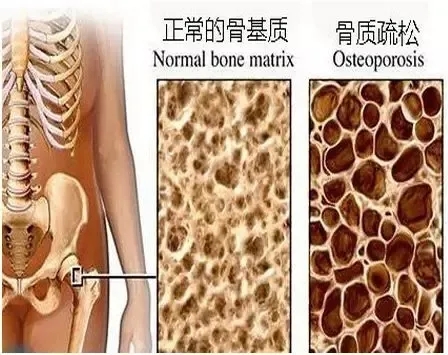Osteoporosis is the most common bone disease in the elderly. For every 3 women and 1 in 5 men, an osteoporotic fracture will occur after the age of 50. Therefore, active prevention and treatment of osteoporosis can reduce the occurrence of fractures. We often encounter such things around us. Why do some people fall down and get up without anything? Why do some people fall and fracture? Everything is at fault with osteoporosis!
First of all, let's understand what osteoporosis is!
Osteoporosis is a systemic bone disease characterized by decreased bone mass, increased bone fragility, and susceptibility to fractures.

It can be seen intuitively from the above picture that the left side is a normal bone, densely packed and very strong. The bone on the right is like a hornet's nest, full of dense holes. It is obvious that the bone on the left side is stronger and less prone to fracture.
For example, the bones of young people can be built in new houses. The walls are clean and strong, not easy to peel and dust, and are not weathered, so they are very resistant to storms and earthquakes; young people are not prone to fractures if they fall. The bones of the elderly are in the old man’s house in disrepair. After a long period of wind and rain, the wall has begun to crack, and the outer lime cement has begun to loosen and fall off. Once an earthquake occurs, the wall begins to shake and collapses most easily.
What are the hazards of osteoporosis?
The first manifestation of osteoporosis is pain.
Osteoporotic pain is mostly low back pain and spontaneous bone pain. The early stage is intermittent dull pain, which gradually develops into persistent pain, and the late stage can cause bone pain throughout the body.
The second manifestation of osteoporosis is a change in body shape. For example, the height becomes shorter, hunchback, kyphosis, chicken breasts, etc.
The third manifestation of osteoporosis is a fracture. Fractures are the most serious complication of osteoporosis. This kind of fracture can happen without too much violence. In daily life, such as twisting the body, bending over to lift heavy objects, riding the bus bumps.
How to check when we suspect osteoporosis?
At present, the most accurate test for osteoporosis is the bone density test. It is recommended to check it once a year, preferably in the same hospital and the same machine. The test results are more accurate. Generally, bone density is divided into four grades:
1. Normal bone mass: T value ≥-1
2. Bone mass reduction: -2.5<T value<-1
3. Osteoporosis: T value ≤—2.5
4. Severe osteoporosis: T value≤—2.5, accompanied by a history of fragility fractures;
How to prevent and treat osteoporosis?
1. Appropriate exercise and sun exposure are the most economical and convenient way to prevent osteoporosis. Various types of exercise help maintain bone mass. Menopausal women persist in 3 hours of exercise a week, and overall calcium increases. Sun exposure can promote the conversion of vitamin D into active vitamin D3 in the skin, thereby promoting calcium absorption and preventing osteoporosis.
2. Good nutrition is important for preventing osteoporosis, including adequate calcium, vitamin D, vitamin C and protein. From childhood, daily diet should have sufficient calcium intake, calcium affects the acquisition of peak bone. Calcium intake is 800 to 1,000 mg for adults, 1,000 to 1,500 mg per day for postmenopausal women, and for men after 65 years of age and other persons at risk of osteoporosis, the recommended calcium intake is 1500 mg/d. Vitamin D intake is 400~800U/d.
3. The chance of falling in patients with osteoporosis should be minimized to reduce hip fractures and Colles fractures.
Here are several recommended high-calcium foods:
1) Yogurt: rich in vitamin D and calcium
2) Milk: A cup of 250ml milk contains 300mg of calcium, which can meet 30% of the daily demand;
3) Spinach: A small bowl of spinach can supplement 25% of the body's daily calcium requirement. In addition, spinach contains good fiber, iron and vitamin A.
4) Cereals: The vitamin D contained in cereals can supplement 25% of the daily demand.
5) Kelp: 100g kelp contains 625mg of calcium.
6) Shrimp skin: Shrimp skin is extremely nutritious. 100g of shrimp skin contains 39.3g of protein, 991mg of calcium, as well as rich minerals and vitamins.
7) Onion: Onion contains a kind of glutamyl peptide, which can prevent mineral loss most effectively.
If the bone density test suggests osteoporosis, do not just treat osteoporosis with calcium supplementation with food, and you must go to the hospital for treatment. Under the guidance of a doctor, medication plus sports food is the best treatment.








